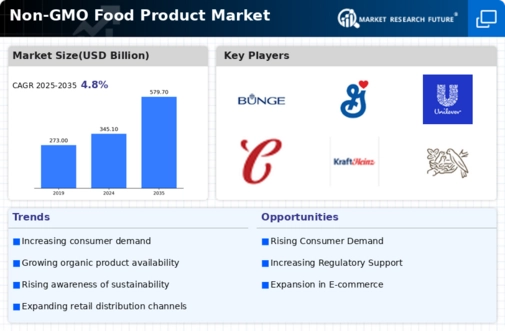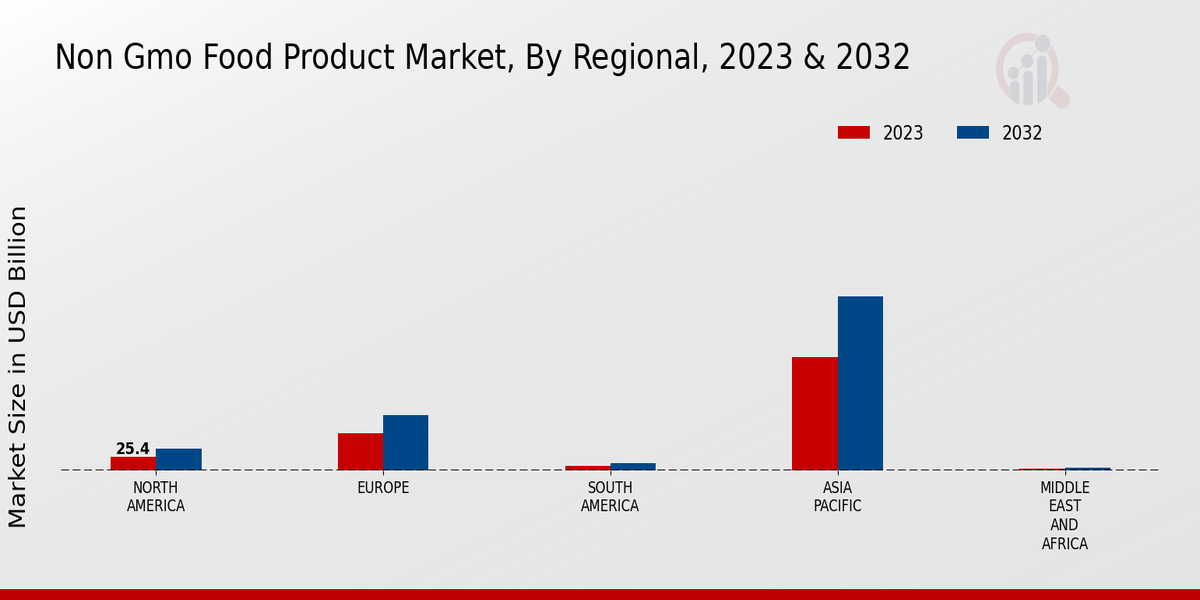Regulatory Support
Government regulations play a pivotal role in shaping the Global Non-GMO Food Product Market Industry. Many countries are implementing stricter labeling requirements for GMO products, thereby enhancing consumer confidence in non-GMO options. For instance, the European Union has established comprehensive regulations that mandate clear labeling of genetically modified foods. Such regulatory frameworks not only protect consumers but also encourage manufacturers to invest in non-GMO product lines. As a result, the market is projected to grow significantly, with estimates suggesting a value of 579.7 USD Billion by 2035. This regulatory support is likely to foster a more favorable environment for non-GMO products, further driving industry expansion.
Sustainability Concerns
Sustainability concerns are becoming a driving force in the Global Non-GMO Food Product Market Industry. Consumers are increasingly aware of the environmental impact of agricultural practices associated with GMOs, leading to a preference for non-GMO products that are perceived as more sustainable. This shift is supported by various initiatives aimed at promoting sustainable farming practices and reducing the ecological footprint of food production. As a result, the demand for non-GMO foods is expected to rise, contributing to the market's growth. The industry's value is anticipated to reach 579.7 USD Billion by 2035, as sustainability becomes a key consideration in consumer purchasing decisions.
Diverse Product Offerings
The Global Non-GMO Food Product Market Industry benefits from a diverse range of product offerings that cater to various consumer preferences. Manufacturers are increasingly expanding their portfolios to include non-GMO options across multiple categories, such as snacks, beverages, and dairy products. This diversification not only meets the growing demand for non-GMO foods but also enhances market accessibility for consumers. As more brands enter the non-GMO space, competition intensifies, leading to innovation and improved product quality. This trend is likely to contribute to the market's projected growth, with a value of approximately 345.1 USD Billion in 2024, as consumers seek variety and quality in their food choices.
Market Growth Projections
The Global Non-GMO Food Product Market Industry is poised for substantial growth, with projections indicating a market value of 579.7 USD Billion by 2035. This growth trajectory is underpinned by a compound annual growth rate (CAGR) of 4.83% from 2025 to 2035. The increasing consumer demand for non-GMO products, coupled with supportive regulatory frameworks and heightened awareness of health and sustainability, suggests a robust market environment. As more consumers prioritize non-GMO options, the industry is likely to witness continued expansion, driven by innovation and diversification in product offerings. This positive outlook reflects the evolving landscape of consumer preferences in the food sector.
Rising Consumer Awareness
The Global Non-GMO Food Product Market Industry experiences a notable increase in consumer awareness regarding the health implications of genetically modified organisms. As individuals become more informed about the potential risks associated with GMOs, they actively seek out non-GMO alternatives. This trend is reflected in the growing demand for organic and non-GMO certified products, which are perceived as healthier options. In 2024, the market is valued at approximately 345.1 USD Billion, indicating a robust consumer shift towards non-GMO products. This heightened awareness is likely to drive further growth in the industry as consumers prioritize transparency and sustainability in their food choices.
Health and Wellness Trends
The Global Non-GMO Food Product Market Industry is significantly influenced by the prevailing health and wellness trends among consumers. A growing segment of the population is increasingly focused on maintaining a healthy lifestyle, which includes dietary choices free from genetically modified ingredients. This trend is particularly evident in the rise of plant-based diets and organic food consumption. As consumers become more health-conscious, the demand for non-GMO products is expected to surge. The market's compound annual growth rate (CAGR) is projected at 4.83% from 2025 to 2035, reflecting the increasing preference for non-GMO foods as part of a holistic approach to health and wellness.
























